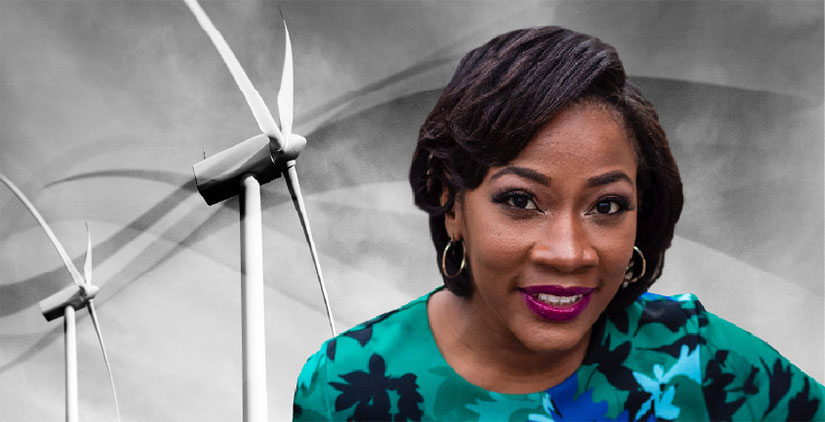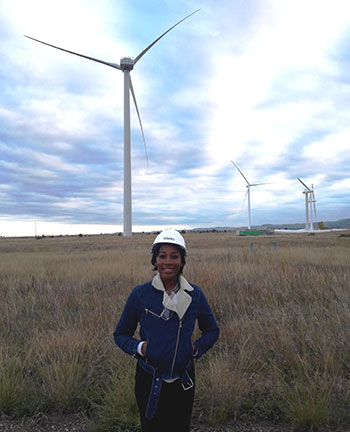Behind the Blades: How Angel McCoy's Background in Meteorology Propels Offshore Wind Forward
An Offshore Wind Energy Regulatory Specialist Discusses Childhood Fascinations, Unexpected Paths, and Nurturing the Dreams of the Next Generation

When Angel McCoy was in third grade, she fell in love with the sky.
“I became obsessed with weather, space, and earth science,” recalled the National Renewable Energy Laboratory (NREL) senior offshore wind regulatory specialist. “I knew I was either going to be a meteorologist or an astronaut when I grew up.”
McCoy chose meteorology and started her career as a meteorologist at the National Weather Service’s Climate Prediction Center, where she worked for four years before taking a job at the U.S. Department of the Interior’s Bureau of Ocean Energy Management (BOEM). That role was not what she expected, but it put her on the path that led to her current role at NREL.
“When I worked at the National Weather Service, I wrote code for things like rainfall modeling, so when I took the job at BOEM, I thought I’d be writing code for wind and solar models,” McCoy said. “It turned out my new job was a regulatory position, which meant I needed to know environmental law. That was a shocking realization, but I saw the need for sound science to inform regulations, so I made a commitment to stick it out for five years. I fell in love with the work and stayed for 12 years.”
Today, McCoy works in NREL’s offshore wind energy program, where she leads engagement with BOEM and the Bureau of Safety and Environmental Enforcement (BSEE) to support the regulatory process for offshore wind energy in the United States. We caught up with McCoy to learn how she made her way to her current role and how she invests in the next generation of scientists and clean energy leaders.
Meteorologist to offshore wind regulatory specialist is a slightly surprising career trajectory! Tell me more about the path that led you here.
I've admired NREL’s work for many years. When I worked at BOEM, I was the subject-matter expert and liaison to NREL. I worked closely with NREL researchers and crossed paths with them for many years at workshops and conferences, and there were times when, while sitting in my regulator seat at BOEM, I would think, “I should be over there with the experts at NREL.” It became a secret dream of mine to join NREL, so when this opportunity became available, I had to go after it.
Now that you are on the research side of offshore wind energy regulation, what do you like about working at NREL?
It's great to have an impact on the industry from the research side, to lead research teams, and mentor junior staff. I love being on a team of people who are the best of the best. We all have an area of expertise, and we all value one another's expertise. We make room for everyone to contribute, and we respect everyone for the value they bring to the team.
Another good thing about NREL is that I have come full circle in many ways. I’ve known several of my current colleagues for years now, having met them at wind and renewable energy workshops or conferences over the years, and now we’re colleagues. I feel that I’ve found my place here. After I left BOEM, I did a short stint as a consultant to offshore wind energy developers. It was good to see that side, but it didn't feel like the right fit for me. Now that I’m at NREL, I feel that my work makes more of a lasting, positive impact, which makes it more rewarding.
And what is your role here at NREL? How would you explain your work in layman’s terms—or, say, to a fifth grader?
Actually, I explain my work to fifth graders all the time! I go to school science fairs and career days, and I run an earth science camp. When I speak to students, I tell them that it’s possible to create electricity from the wind, and then I ask them if they've ever seen wind turbines on land before. Most kids will say they have, or they’ve at least seen pictures of them. From there, I say, “We can also build wind turbines out in the ocean where there’s more wind. My job is to help build offshore wind turbines safely and in a way that minimally impacts, for example, people and animals who live by the ocean or people who use the ocean for fishing.”
You also run a science camp? Tell me more!
For many years, I volunteered at schools, doing hands-on earth science workshops and presenting at assemblies and science fairs. Eventually, the teachers, counselors, and principals said, “You know, schools have budgets to pay for stuff like this. You don’t have to do it for free.” Now, I run a science camp called Discover Earth Camp. It's my passion project. Part of the motivation comes from my own childhood fascination with the sky, so my goal for Discover Earth Camp is to expose other children to earth science and the natural world, because if I catch them as children, then I’ve got them for life.
Running a science camp for kids is also having a big impact—on the next generation. You mentioned you mentor junior staff at NREL, too. What advice do you have for young people, college students, or those who are early in their careers?
Don't limit yourself! When you’re young or just starting out, you may have a strong idea of what you want to be when you grow up or you may have one area where you’re especially knowledgeable, but I found my path because I was open to more than what I was initially seeking. Allow yourself some wiggle room to explore other opportunities. You may stumble across something else that interests you along the way. Then, you've picked up expertise in something that you never expected.
Also, look back and celebrate how far you've come. Don't forget those who have mentored you or guided you with even a simple word of encouragement along the way. I had a milestone birthday celebration in January, and I have been very reflective of all the people who I have crossed paths with and who helped keep me going or helped propel me to where I am now—some of whom are now my colleagues at NREL.
It is great that you are inspiring the next generation. Let’s assume you are still explaining your work to one of the fifth graders at your camp. Can you explain why is your work important? What problems does your work attempt to solve?
With fifth graders, first they need to understand why wind energy is important. I tell them, “The traditional ways that we get electricity to our homes can hurt the environment, and so we have other resources, like the sun and the wind, that we can use to get cleaner forms of energy to our homes. This way, we can keep our planet healthy for future generations.”
Getting more into the regulatory aspects of offshore wind energy, I would say, “Whenever the government must make a decision, like whether to approve a new offshore wind energy project, sometimes they don’t have all the information they need right in front of them. That’s when they turn to NREL researchers and say, for example, ‘We need to better understand the available wind resource out here in the Pacific,’ or, ‘We need to understand the technological constraints of transmission or anchoring to the sea floor.’ Basically, I support the research that helps people in government make decisions and develop regulations around offshore wind energy.”
It is clear that your work is very important for the advancement of U.S. offshore wind energy. What have you accomplished in your career that you are especially proud of?

I’ve worked in offshore wind energy for 14 years now, and since the U.S. offshore wind energy industry is so new, I’m almost like an industry veteran. I’m proud to see the influence I’ve had on this industry.
For example, when I worked at BOEM, I wrote the guidelines for lighting and marking U.S. offshore wind facilities. There is no regulatory authority for how we should light, paint, and mark these structures out in the ocean. I developed guidelines that ensure safe air and sea navigation within and around facilities while also ensuring that the design is safe for birds and marine animals. Now, the entire U.S. offshore wind industry refers to them.
Now that we have reflected on your past, let’s talk dreams. What are your hopes for the future of wind energy and its workforce?
We've been working at U.S. offshore wind energy development for so long now, I just can't wait to see a full-scale commercial facility operating in federal waters—and that's right around the corner. I feel like I'm going to shed a tear when that day comes.
Also, I know the administration has the goal of 30 gigawatts of operational offshore wind by 2030, but even if we could have 30 gigawatts approved and secured in the pipeline, that would be awesome. If we can reach those short-term milestones, it will be great for the industry.
Finally, I look forward to the accomplishments of those coming up behind me. I was just at the American Meteorological Society's annual meeting last week participating in the energy track, and I was talking to a lot of college students and other young people, and they were picking my brain, asking questions about the future of offshore wind. It was exciting to say I was on the front lines of making U.S. offshore wind energy a reality, but now I can look to the next generation to run a successful, functioning industry. The way I see it, my role is to make it happen now. It's the next generation’s role to keep it going.
Learn more about NREL’s wind energy research, offshore wind energy in particular, and the amazing people behind the blades by subscribing to the Leading Edge newsletter.
Last Updated May 28, 2025
